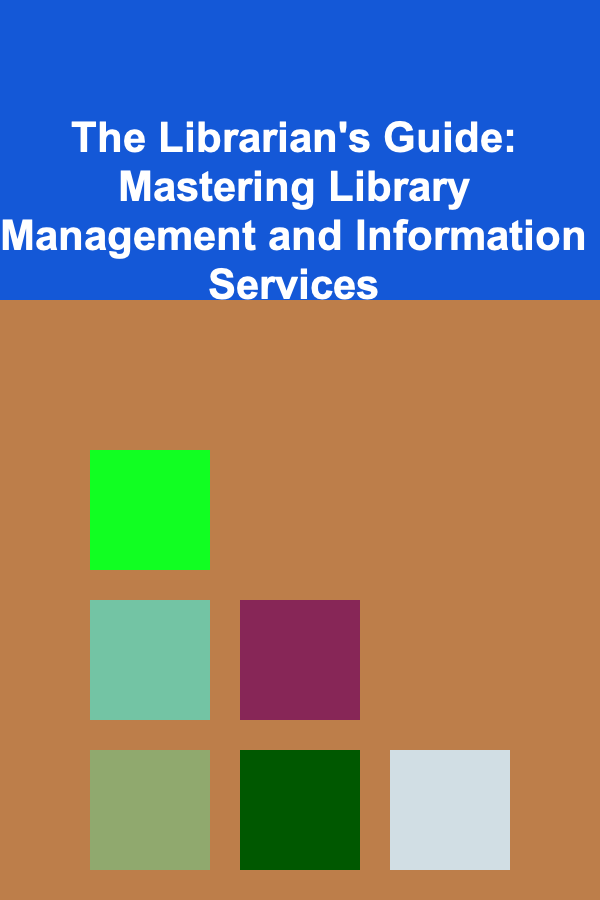
The Librarian's Guide: Mastering Library Management and Information Services
ebook include PDF & Audio bundle (Micro Guide)
$12.99$6.99
Limited Time Offer! Order within the next:

Libraries have evolved far beyond their traditional role as repositories of books. Today, they are dynamic centers of knowledge, culture, and community engagement. As librarians, we are tasked not only with maintaining collections but also with managing complex systems that support information services, user engagement, and organizational efficiency. This actionable guide will explore how librarians can master library management and information services, offering practical insights on how to manage resources, implement effective systems, and meet the ever-changing needs of library patrons.
Understanding Library Management
Library management refers to the processes and strategies involved in the organization, administration, and operation of a library. It encompasses everything from resource management to staff supervision, budgeting, and program development. Effective library management is critical for ensuring that libraries can deliver high-quality services while staying responsive to user needs.
Good library management blends traditional methods of organizing materials with modern technological tools to optimize efficiency, improve accessibility, and foster innovation.
Key Principles of Library Management
- Efficiency: A well-managed library maximizes resources, time, and energy. Streamlining processes like cataloging, resource acquisition, and information retrieval ensures smooth day-to-day operations.
- Adaptability: Libraries must constantly adapt to new technology, trends in information access, and evolving user needs. Flexibility in management practices allows libraries to stay relevant in a rapidly changing environment.
- Transparency and Accountability: Effective library management involves clear communication with staff and patrons, as well as regular evaluation of programs and services. Managers should be accountable for decisions and transparent about resource allocation.
- User-Centered Focus: At the heart of library management should be the community it serves. Every decision---from acquiring resources to creating services---should be based on the needs and interests of the library's users.
Mastering Information Services
Information services in libraries refer to the processes that involve gathering, organizing, and disseminating information to users. This encompasses everything from reference services to digital resources, research assistance, and information literacy programs. As information access evolves, librarians must become adept in managing both traditional and digital resources.
Actionable Steps for Mastering Information Services
1. Develop and Maintain a Robust Information System
An efficient information system is essential for managing both physical and digital collections. This includes a well-organized cataloging system, easy-to-use search interfaces, and integrated databases that provide users with quick access to resources.
- Implement Integrated Library Systems (ILS): Modern ILS platforms like Koha, Alma, or Evergreen allow for seamless management of library resources, including cataloging, circulation, and acquisitions. These systems help librarians track usage patterns, manage inventory, and streamline operations.
- Cataloging and Metadata: Ensure that both physical and digital resources are cataloged with accurate metadata. Utilize international standards like MARC (Machine-Readable Cataloging) or RDA (Resource Description and Access) to ensure consistency in your catalog records.
- Cloud-Based Services: Adopting cloud-based systems allows for real-time access to digital resources and simplifies collaboration among library staff across multiple locations. Cloud storage ensures the long-term preservation and easy retrieval of digital content.
2. Leverage Technology for Information Retrieval
Technology plays a critical role in how information is retrieved and accessed by library users. In an era where digital tools are ubiquitous, librarians must stay ahead of the curve in providing easy access to both digital and physical information.
- Search Engine Optimization (SEO): Make your library's online catalog and resources easy to find by optimizing search engines. By using keywords, metadata, and optimized descriptions, you can improve the discoverability of your library's digital assets.
- Resource Discovery Tools: Implement systems that integrate all of your library's resources---books, journals, databases, and more---into a single search interface. Discovery platforms like Summon or Primo can enhance a user's search experience, enabling them to quickly find relevant content across multiple formats.
- Artificial Intelligence (AI): Explore AI-driven solutions for providing personalized information services. AI tools can be used to recommend resources based on user history or preferences, improving the overall user experience.
3. Focus on Information Literacy and Education
As information access becomes increasingly democratized through the internet, the need for information literacy has never been greater. Libraries have a critical role to play in teaching users how to critically evaluate and use information.
- Offer Information Literacy Programs: These programs should be aimed at teaching users how to search for, evaluate, and ethically use information. For example, you can offer workshops on citation practices, evaluating sources, or avoiding plagiarism.
- Collaboration with Educators: Collaborate with schools, universities, and other educational institutions to embed information literacy into curricula. Libraries can provide supplemental instruction and resources that complement classroom learning.
- Digital Literacy: In addition to information literacy, libraries must promote digital literacy. This can include teaching users how to use the internet safely, how to navigate digital platforms, and how to engage with online content critically.
4. Enhance Reference Services
Reference services provide crucial support for library users who need assistance in locating information, solving research problems, or learning how to use library resources. These services can be offered in-person or digitally.
- Train Staff: Provide ongoing training for library staff in reference management and research techniques. A knowledgeable reference librarian is key to ensuring that patrons receive the help they need.
- Virtual Reference Services: Virtual reference services, such as chat or email-based assistance, allow users to ask questions and receive guidance without needing to be physically present in the library. Offering remote assistance is particularly useful in today's digital-first world.
- Resource Curation: Create specialized guides or research resources tailored to specific user groups or topics. This can include creating subject guides or assembling a collection of resources on trending topics or emerging research fields.
Managing Library Resources
Effective resource management ensures that libraries can provide relevant and up-to-date content to their patrons, whether that be physical books or digital media. Managing a diverse range of resources can be challenging, but a solid management strategy can make this task more manageable.
Actionable Steps for Resource Management
1. Develop a Comprehensive Acquisition Strategy
Acquiring resources that align with user needs and library goals is a fundamental aspect of library management. An acquisition strategy ensures that resources are chosen based on community interest, availability, and long-term value.
- Engage with Users: Solicit feedback from your library's users through surveys or focus groups to better understand the types of resources they need. This can help guide your collection development process.
- Evaluate Resources: Consider both print and digital resources. Stay updated on emerging trends, such as e-books, digital media, and open-access journals, and ensure that your collection remains relevant in the digital age.
- Manage Budgets Effectively: Resource acquisition should be budgeted carefully. Prioritize spending on resources that will provide the greatest impact for your users while ensuring that your library's overall budget remains balanced.
2. Implement Effective Circulation Systems
A streamlined circulation system is essential for ensuring that resources are efficiently checked out and returned. Technology plays a crucial role in managing circulation.
- Self-Check Stations: Implement self-checkout kiosks that allow users to check out materials independently. This can save time for both patrons and library staff while enhancing user satisfaction.
- Monitor Usage Data: Track circulation patterns to better understand which materials are in high demand. This data can inform future acquisitions, helping you maintain a collection that meets user needs.
- Automated Renewals: Implement automated systems that allow users to renew materials online, saving them time and reducing the administrative workload for staff.
3. Preserve and Maintain Collections
Library collections, especially rare or valuable materials, need to be preserved for future generations. Effective preservation practices ensure that materials remain intact and accessible.
- Climate Control and Storage: Ensure that your library has proper storage conditions for rare books and archival materials. This may involve climate-controlled storage, protective covers, or digital preservation methods.
- Digitization: For older materials, consider digitizing content to protect it from wear and tear. Digitization also provides wider access, allowing materials to be accessed remotely.
- Conservation Efforts: Invest in conservation practices, such as repairing damaged books or restoring fragile documents. Collaborating with professional conservators can help ensure that your materials are preserved for years to come.
Leadership and Staff Management
The success of a library depends not only on its systems and resources but also on its people. Effective leadership and staff management are essential for creating a positive and productive work environment that serves both staff and patrons.
Actionable Steps for Effective Leadership and Staff Management
1. Foster a Collaborative Environment
Encourage a collaborative culture where library staff can share ideas, feedback, and strategies. Regular meetings, team-building activities, and open communication channels help foster a sense of unity and purpose.
- Inclusive Leadership: Ensure that leadership decisions are made with input from staff at all levels. Involve staff in decision-making processes, especially when it comes to new initiatives or changes in library services.
- Promote Professional Development: Provide opportunities for ongoing training and development, ensuring that staff members have the skills and knowledge to meet the needs of users. This can include workshops, conferences, or certifications in areas like digital literacy or library technology.
2. Performance Evaluation and Feedback
Regular performance evaluations help ensure that staff members are meeting expectations and provide an opportunity to address challenges and offer support.
- Set Clear Expectations: Make sure that staff understand their roles and responsibilities, as well as the library's overall goals. Regularly review these expectations to ensure alignment with the library's mission.
- Provide Constructive Feedback: Offer feedback in a way that encourages growth and improvement. Recognize staff achievements and identify areas where additional training or support may be needed.
Conclusion
Mastering library management and information services requires a multi-faceted approach. By embracing both traditional practices and innovative technologies, librarians can manage resources, improve user access to information, and provide valuable community services. Whether through refining information systems, improving reference services, managing resources effectively, or fostering a collaborative staff environment, these actionable strategies help libraries adapt to the changing landscape and continue to thrive as centers of knowledge, culture, and community engagement.
Reading More From Our Other Websites
- [Organization Tip 101] How to Use Technology to Streamline Music Organization
- [Simple Life Tip 101] How to Build a Capsule Wardrobe Using Sustainable Fabrics for a Truly Simple Life
- [Personal Care Tips 101] How to Pick the Right Toothbrush for Your Specific Oral Care Needs
- [Home Soundproofing 101] How to Soundproof a Home Theater Room for an Immersive Experience
- [Whitewater Rafting Tip 101] Seasonal Water Level Shifts and Their Effect on Rafting Routes
- [Personal Investment 101] How to Master Personal Finance Basics Before You Start Investing
- [Home Security 101] How to Secure Second-Floor Windows: Protecting Your Home from Above
- [Organization Tip 101] How to Set Up a Hydration Station in Your Workout Space
- [Home Cleaning 101] How to Sanitize Your Kitchen Without Harsh Chemicals
- [Personal Finance Management 101] How to Avoid Common Money Mistakes and Set Yourself Up for Success

How to Create an Inventory Restocking Checklist for Efficient Management
Read More
How to Secure Your Home with a Multi-Layered Security Strategy
Read More
How to Streamline Your Workflow with Digital Templates
Read More
How to Use 3D Visualization Tools in Your Home Renovation Planning
Read More
How to Optimize Your Customer Support Engineering Workflow
Read More
How to Navigate Picky Eating with a Toddler Behavior Planner
Read MoreOther Products

How to Create an Inventory Restocking Checklist for Efficient Management
Read More
How to Secure Your Home with a Multi-Layered Security Strategy
Read More
How to Streamline Your Workflow with Digital Templates
Read More
How to Use 3D Visualization Tools in Your Home Renovation Planning
Read More
How to Optimize Your Customer Support Engineering Workflow
Read More